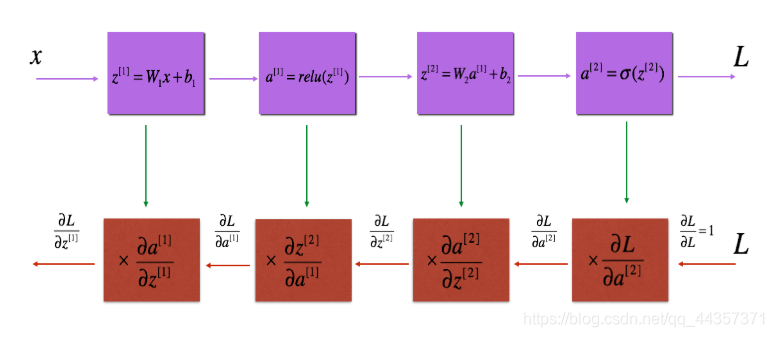深层神经网络编程作业1
创建时间:
字数:808
阅读:

导包
1
2
3
4
5
6
7
8
9
10
11
12
13
14
15
| import numpy as np
import h5py
import matplotlib.pyplot as plt
from testCases_v4 import *
from dnn_utils_v2 import sigmoid, sigmoid_backward, relu, relu_backward
%matplotlib inline
plt.rcParams['figure.figsize'] = (5.0, 4.0)
plt.rcParams['image.interpolation'] = 'nearest'
plt.rcParams['image.cmap'] = 'gray'
%load_ext autoreload
%autoreload 2
np.random.seed(1)
|
浅层神经网络参数初始化
1
2
3
4
5
6
7
8
9
10
11
12
13
14
15
16
17
18
| def initialize_parameters(n_x, n_h, n_y):
np.random.seed(1)
W1 = np.random.randn(n_h, n_x)*0.01
b1 = np.zeros((n_h, 1))
W2 = np.random.randn(n_y, n_h)*0.01
b2 = np.zeros((n_y, 1))
assert(W1.shape == (n_h, n_x))
assert(b1.shape == (n_h, 1))
assert(W2.shape == (n_y, n_h))
assert(b2.shape == (n_y, 1))
parameters = {"W1": W1,
"b1": b1,
"W2": W2,
"b2": b2}
return parameters
|
L层神经网络参数初始化
1
2
3
4
5
6
7
8
9
10
11
12
13
| def initialize_parameters_deep(layer_dims):
np.random.seed(3)
parameters = {}
L = len(layer_dims)
for l in range(1, L):
parameters['W'+str(l)] = np.random.randn(layer_dims[l], layer_dims[l-1])*0.01
parameters['b'+str(l)] = np.zeros((layer_dims[l], 1))
assert(parameters['W'+str(l)].shape == (layer_dims[l], layer_dims[l-1]))
assert(parameters['b'+str(l)].shape == (layer_dims[l], 1))
return parameters
|
实现一个单层正向传播
1
2
3
4
5
6
7
| def linear_forward(A, W, b):
Z = np.dot(W, A) +b
assert(Z.shape == (W.shape[0], A.shape[1]))
cache = (A, W, b)
return Z, cache
|
对一层激活并向前传播(activation_cache存Z,linear_cache存A、W、b)
1
2
3
4
5
6
7
8
9
10
11
12
| def linear_activation_forward(A_prev, W, b, activation):
if activation=="sigmoid":
Z, linear_cache = linear_forward(A_prev, W, b)
A, activation_cache = sigmoid(Z)
elif activation=="relu":
Z, linear_cache = linear_forward(A_prev, W, b)
A, activation_cache = relu(Z)
assert(A.shape == (W.shape[0], A.shape[1]))
cache = (linear_cache, activation_cache)
return A, cache
|
L层正向传播
1
2
3
4
5
6
7
8
9
10
11
12
13
14
15
16
| def L_model_forward(X, parameters):
caches = []
A = X
L = len(parameters)//2
for l in range(1, L):
A_prev = A
A,cache = linear_activation_forward(A_prev, parameters['W'+str(l)], parameters['b'+str(l)], "relu")
caches.append(cache)
AL, cache = linear_activation_forward(A, parameters['W'+str(L)], parameters['b'+str(L)], "sigmoid")
caches.append(cache)
assert(AL.shape == (1,X.shape[1]))
return AL, caches
|
损失函数
1
2
3
4
5
6
7
8
| def compute_cost(AL, Y):
m = Y.shape[1]
cost = -1/m*np.sum(Y*np.log(AL)+(1-Y)*np.log(1-AL))
cost = np.squeeze(cost)
assert(cost.shape == ())
return cost
|


单层向后传播
1
2
3
4
5
6
7
8
9
10
11
12
13
| def linear_backward(dZ, cache):
A_prev, W, b = cache
m = A_prev.shape[1]
dW = 1/m * np.dot(dZ, A_prev.T)
db = 1/m * np.sum(dZ, axis=1, keepdims=True)
dA_prev = np.dot(W.T, dZ)
assert(dW.shape == W.shape)
assert(db.shape == b.shape)
assert(dA_prev.shape == A_prev.shape)
return dA_prev, dW, db
|
对单层激活并向后传播
1
2
3
4
5
6
7
8
9
10
11
| def linear_activation_backward(dA, cache, activation):
linear_cache, activation_cache = cache
if activation=="relu":
dZ = relu_backward(dA, activation_cache)
dA_prev, dW, db = linear_backward(dZ, linear_cache)
elif activation=="sigmoid":
dZ = sigmoid_backward(dA, activation_cache)
dA_prev, dW, db = linear_backward(dZ, linear_cache)
return dA_prev, dW, db
|

L层向后传播
1
2
3
4
5
6
7
8
9
10
11
12
13
14
15
16
17
18
19
20
21
| def L_model_backward(AL, Y, caches):
grads={}
L = len(caches)
m = AL.shape[1]
Y = Y.reshape(AL.shape)
dAL = - (np.divide(Y, AL) - np.divide(1 - Y, 1 - AL))
current_cache = caches[L-1]
grads["dA"+str(L-1)], grads["dW"+str(L)], grads["db"+str(L)] = linear_activation_backward(dAL, current_cache, "sigmoid")
for l in reversed(range(L-1)):
current_cache = caches[l]
dA_prev_temp, dW_temp, db_temp = linear_activation_backward(grads["dA" + str(l + 1)], current_cache, "relu")
grads["dA" + str(l)] = dA_prev_temp
grads["dW" + str(l + 1)] = dW_temp
grads["db" + str(l + 1)] = db_temp
return grads
|
更新参数
1
2
3
4
5
6
7
| def update_parameters(parameters, grads, learning_rate):
L = len(parameters) // 2
for l in range(L):
parameters["W"+str(l+1)] = parameters["W"+str(l+1)]-learning_rate*grads["dW"+str(l+1)]
parameters["b"+str(l+1)] = parameters["b"+str(l+1)]-learning_rate*grads["db"+str(l+1)]
return parameters
|
1
2
3
4
5
6
7
| parameters, grads = update_parameters_test_case()
parameters = update_parameters(parameters, grads, 0.1)
print ("W1 = "+ str(parameters["W1"]))
print ("b1 = "+ str(parameters["b1"]))
print ("W2 = "+ str(parameters["W2"]))
print ("b2 = "+ str(parameters["b2"]))
|
W1 = [[-0.59562069 -0.09991781 -2.14584584 1.82662008]
[-1.76569676 -0.80627147 0.51115557 -1.18258802]
[-1.0535704 -0.86128581 0.68284052 2.20374577]]
b1 = [[-0.04659241]
[-1.28888275]
[ 0.53405496]]
W2 = [[-0.55569196 0.0354055 1.32964895]]
b2 = [[-0.84610769]]
转载请注明来源,欢迎对文章中的引用来源进行考证,欢迎指出任何有错误或不够清晰的表达。可以在下面评论区评论,也可以邮件至 2470290795@qq.com





